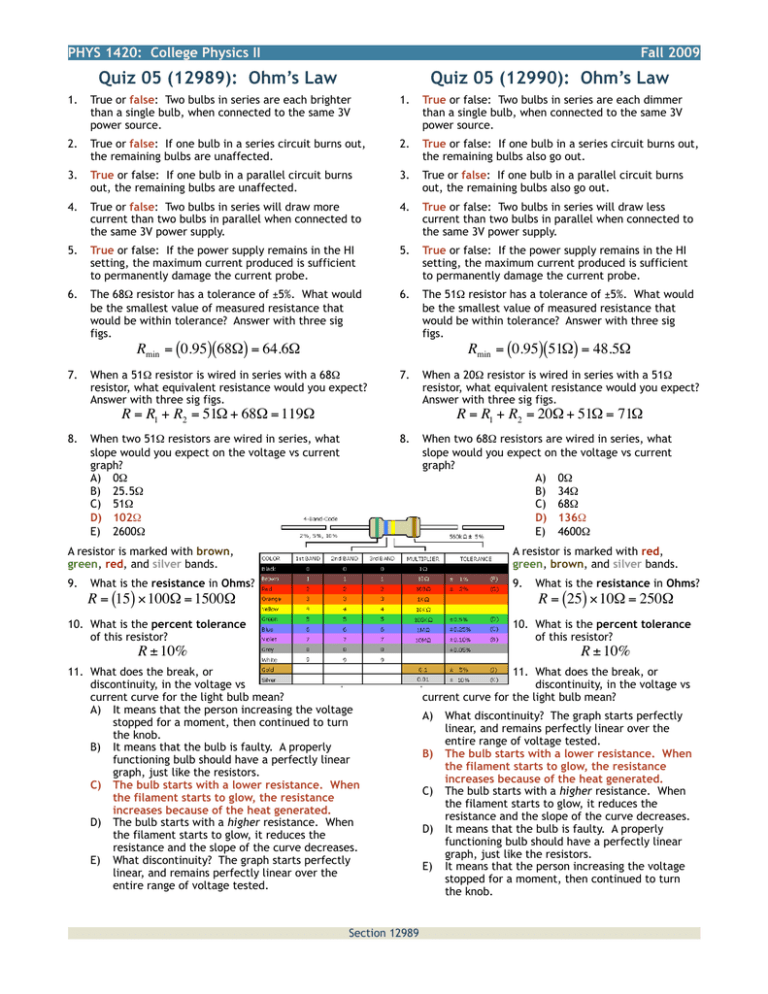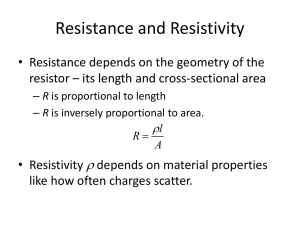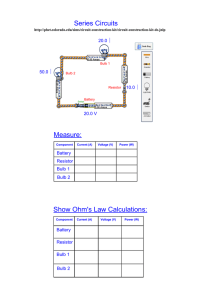Quiz 05
advertisement

PHYS 1420: College Physics II Fall 2009 Quiz 05 (12989): Ohm’s Law Quiz 05 (12990): Ohm’s Law 1. True or false: Two bulbs in series are each brighter than a single bulb, when connected to the same 3V power source. 1. True or false: Two bulbs in series are each dimmer than a single bulb, when connected to the same 3V power source. 2. True or false: If one bulb in a series circuit burns out, the remaining bulbs are unaffected. 2. True or false: If one bulb in a series circuit burns out, the remaining bulbs also go out. 3. True or false: If one bulb in a parallel circuit burns out, the remaining bulbs are unaffected. 3. True or false: If one bulb in a parallel circuit burns out, the remaining bulbs also go out. 4. True or false: Two bulbs in series will draw more current than two bulbs in parallel when connected to the same 3V power supply. 4. True or false: Two bulbs in series will draw less current than two bulbs in parallel when connected to the same 3V power supply. 5. True or false: If the power supply remains in the HI setting, the maximum current produced is sufficient to permanently damage the current probe. 5. True or false: If the power supply remains in the HI setting, the maximum current produced is sufficient to permanently damage the current probe. 6. The 68Ω resistor has a tolerance of ±5%. What would be the smallest value of measured resistance that would be within tolerance? Answer with three sig figs. 6. The 51Ω resistor has a tolerance of ±5%. What would be the smallest value of measured resistance that would be within tolerance? Answer with three sig figs. Rmin = (0.95)(68Ω) = 64.6Ω 7. € 8. € Rmin = (0.95)(51Ω) = 48.5Ω When a 51Ω resistor is wired in series with a 68Ω resistor, what equivalent resistance would you expect? Answer with three sig figs. 7. R = R1 + R2 = 51Ω + 68Ω = 119Ω When a 20Ω resistor is wired in series with a 51Ω resistor, what equivalent resistance would you expect? Answer with three sig figs. R = R1 + R2 = 20Ω + 51Ω = 71Ω € When two 51Ω resistors are wired in series, what slope would you expect on the voltage vs current graph? A) 0Ω B) 25.5Ω C) 51Ω D) 102Ω E) 2600Ω 8. € When two 68Ω resistors are wired in series, what slope would you expect on the voltage vs current graph? A) 0Ω B) 34Ω C) 68Ω D) 136Ω E) 4600Ω A resistor is marked with brown, green, red, and silver bands. A resistor is marked with red, green, brown, and silver bands. 9. 9. What is the resistance in Ohms? R = (15) ×100Ω = 1500Ω R = (25) ×10Ω = 250Ω 10. What is the percent tolerance of this resistor? € What is the resistance in Ohms? 10. What is the percent tolerance of this resistor? R ± 10% 11. What does the break, or discontinuity, in the voltage vs current curve for the light bulb mean? € A) It means that the person increasing the voltage stopped for a moment, then continued to turn the knob. B) It means that the bulb is faulty. A properly functioning bulb should have a perfectly linear graph, just like the resistors. C) The bulb starts with a lower resistance. When the filament starts to glow, the resistance increases because of the heat generated. D) The bulb starts with a higher resistance. When the filament starts to glow, it reduces the resistance and the slope of the curve decreases. E) What discontinuity? The graph starts perfectly linear, and remains perfectly linear over the entire range of voltage tested. Section 12989 € R ± 10% 11. What does the break, or discontinuity, in the voltage vs current curve for the light bulb mean? A) B) C) D) E) € The graph starts perfectly What discontinuity? linear, and remains perfectly linear over the entire range of voltage tested. The bulb starts with a lower resistance. When the filament starts to glow, the resistance increases because of the heat generated. The bulb starts with a higher resistance. When the filament starts to glow, it reduces the resistance and the slope of the curve decreases. It means that the bulb is faulty. A properly functioning bulb should have a perfectly linear graph, just like the resistors. It means that the person increasing the voltage stopped for a moment, then continued to turn the knob.





